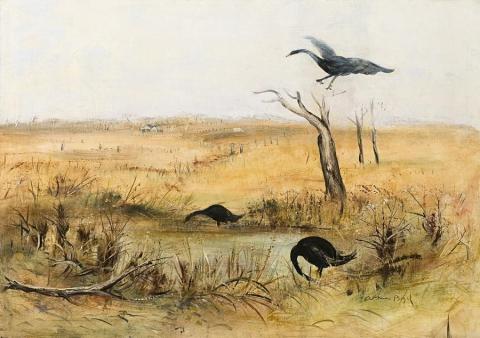WIMMERA LANDSCAPE WITH BLACK SWANS,1950 - 52
ARTHUR BOYD
tempera on board
58.0 x 81.0 cm
signed lower right: Arthur Boyd
Collection of Mr H.W. Harris, Mildura, Victoria
Sotheby's, Melbourne, 26 July 1987, lot 437
Private collection, Brisbane
Philipp, F., Arthur Boyd, Thames and Hudson, London, 1967, cat. 5.52, p. 248
Arthur Boyd's Wimmera paintings are at their heart Pastorals in the great European tradition of rural landscape painting. Like John Constable over a century earlier, Boyd painted from nature and found a deep romanticism in provincial farming life that gave his works an air of renew a land optimism even among the grass tussocks and dry fields of northwest Victoria in the 1950s. As Barry Pearce comments about the artist, 'he has always been a traditionalist'. 'Boyd stood in the river of European tradition, took from it what he needed, and proceeded to give back something of his own.'1 Wimmera Landscape with Black Swans painted between 1950 and 1952 takes as its subject the life giving waterhole and a group of black swans which appear to have migrated towards even the scarcest of water sources in an otherwise dry and parched countryside. In the distance, a lone cow grazes in a brown paddock alongside a lean-to farmhouse, or shed. Yet in the foreground three robust black swans provide one of the few signs of life in this sparse composition.
The Wimmera landscapes were painted just after Boyd completed a series of murals in casein tempera for his uncle's property The Grange in Harkaway in 1949. He had been discharged from the Army in1944 during which time he produced a group of works replete with tortured, grotesque souls and apocalyptic events. As Robert Hughes commented, 'The war convulsed Boyd's arcadian plein-airism into the violent expressionist images.'2 Shortly thereafter he completed a remarkable series of Old Testament paintings including The Golden Calf and The Expulsion. It was to be a particularly creative and productive time for Boyd and with this substantial body of work behind him here turned to his interest in the pastoral. Following a series of Breugel-inspired Harkaway landscapes, Boyd embarked on a painting expedition to Horsham and deeper into the Wimmera in 1949, returning again over the next few years. Mostly painted in tempera, this first series of Wimmera works are characterised by their translucence and light. While the biblical works and the Harkaway landscapes are surging with activity and throngs of people, Boyd's Wimmera paintings are full of solitude and stillness as though at last he had found some peace in the quiet, dry air of north west Victoria.
1. Pearce, B., Arthur Boyd - Retrospective, Art Gallery of New South Wales, Sydney, 1993, p. 11
2. Hughes, R., in Pearce, op. cit., p. 14
LARA NICHOLLS
